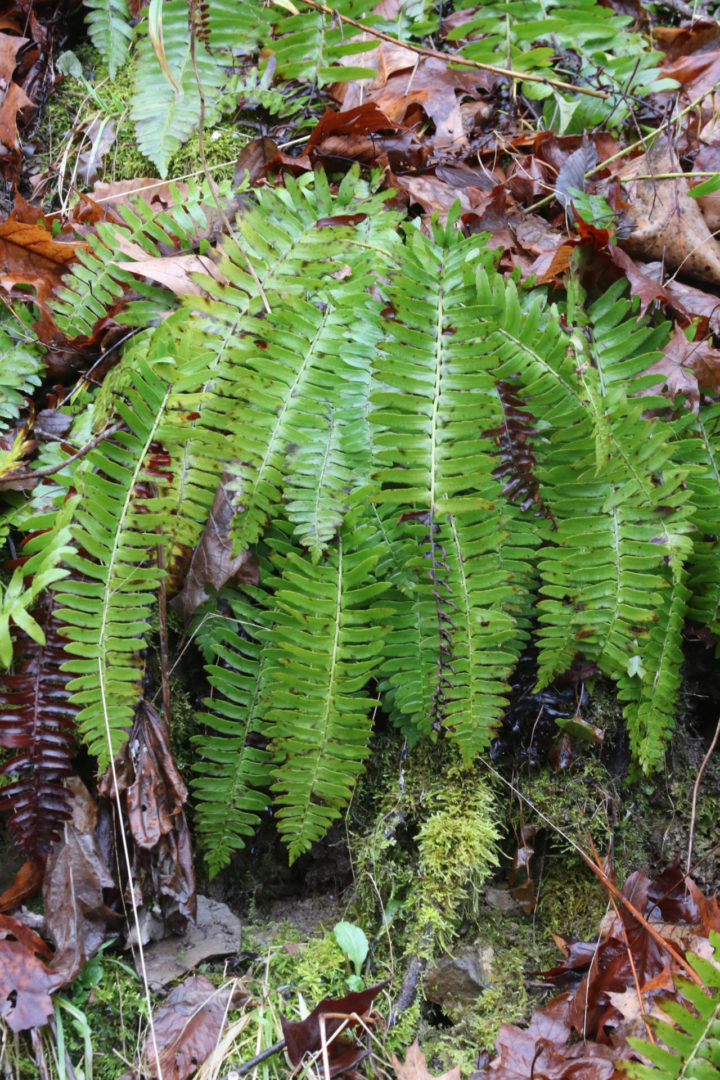One of our most common fern species is the Christmas fern. While it never grows to the level of profusion of hay-scented fern, it does occur in all of Pennsylvania’s 67 counties.
Christmas ferns (Polystichum acrostichoides) grow in fountain-like clumps of dark green fronds that stand from 1 to 2 feet tall.
Their stocking-shaped leaflets are alternately arranged up the spine of each frond, with the larger leaflets found near the base. The fronds of Christmas fern are somewhat leathery to the touch.
It is one of the few ferns that still remain green during the last week of December. Its evergreen nature and attractive foliage made it an easy choice for wreaths and other Christmas decorations in days gone by. Its use as a seasonal decoration probably led to its common name.
By spring, winter snows have plastered the once graceful but still green fronds flat to the ground. Christmas fern doesn’t stay down for long, however, for it is one of the first ferns to begin reaching for the sky anew each spring. Emerging as “fiddleheads,” the new young fronds appear curled in pinwheel fashion from the center of the cluster of last year’s fronds. Fiddleheads are covered with silvery hairs and scales. They are easily spotted in the early spring.
Christmas fern is found in a variety of well-drained soils having an acidic to neutral pH value. This perennial plant thrives in rich, damp humus but rarely grows in waterlogged soils. It grows well on stream banks, wooded slopes and sometimes very steep slopes — there, it helps to prevent erosion. It prefers shade and partial shade, but it does tolerate more sunlight than many other ferns.
The reproductive fronds in each clump are usually the tallest because they grow straight up. The backs of each leaflet on the upper third of the fronds are densely covered with tiny spore-producing sori. Spores are produced June through October.
If you are unfamiliar with ferns, you might not realize that if a fern spore lands on favorable habitat, it grows into a very small intermediate form called a prothallus.
These tiny heart-shaped plants grow flat to the ground and look like a miniature leaf less than half the size of the nail on your pinky finger. Sexual reproduction occurs on the prothallus, and a new asexual fern plant forms.
In addition to producing spores, Christmas ferns grow from their underground rhizoids, creating larger clumps and thick patches, just as most ferns do.
Christmas fern is a very good choice for shaded rock gardens or naturalizing on wooded lots. They require little care.
So little, Fine Gardening called the plant “particularly accommodating.” Christmas fern can also be used for controlling erosion on wooded slopes. Deer rarely eat Christmas fern and only do so if there is nothing else to eat.
Nursery-grown plants can be purchased locally or through online sources. A recent check located many online nurseries with prices ranging from $6 to $50.
Christmas fern grows in hardiness zones 3 through 8. Zones 5, 6 and 7 are found in Pennsylvania, so it is no surprise that the fern grows well here. Northern New York and some of New England has weather that reaches the edge of its northern tolerance and beyond.
While common in Pennsylvania and most of the eastern United States, Christmas fern is listed as “threatened” in Minnesota and “exploitably vulnerable” in New York.
This column appears in the Dec. 22-28 edition of The Centre County Gazette.



